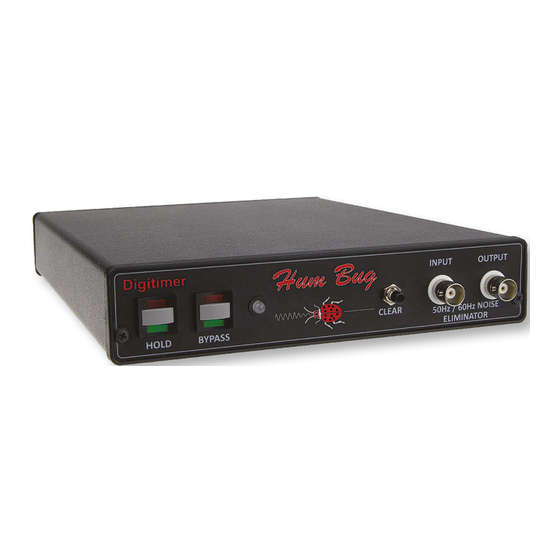
Summary of Contents for Digitimer Hum Bug
- Page 1 Digitimer Hum Bug 50/60Hz Noise Eliminator OPERATOR’S MANUAL For Research Use Only “Digitimer” is a registered trademark of Digitimer Limited...
-
Page 2: Product Registration
OPERATOR’S MANUAL: HUM BUG 50/60Hz NOISE ELIMINATOR Issue 01 PRODUCT REGISTRATION Please take time out to register your new product. You can even do it online at:- www.digitimer.com/register Digitimer Hum Bug 50/60Hz Noise Eliminator Copyright © 2024 Copyright © 2024... -
Page 3: Contact Addresses
Suite 700 Fort Lauderdale, FL 33301 t: +1 954 334-1070 f: +1 954 206-6227 e: svalenti@digitimer.com Please contact Digitimer for information regarding representation in other countries. Copyright © 2024 Copyright © 2024 4 | Digitimer Digitimer | 5 Last revised Feb2024... -
Page 4: Warranty Information
For a speedy response to all your questions now and in the future, please take time out to Digitimer Limited warrants to the first purchaser, for a period of one year from the date of register your new Hum Bug at www.digitimer.com/register now! Product registration purchase, that this Digitimer instrument (hereafter referred to as the “Product”) will be free... - Page 5 Supplied accessories A. The Hum Bug fails to operate Optional accessories B. The Hum Bug is operating but noise cancellation is inadequate or abnormal Precautions and warnings C. The output of the Hum Bug has too much baseline noise Operator's manual D.
- Page 6 The Hum Bug is not a filter. It is a new class of instrument capable of eliminating electrical interference from analogue signals without creating phase shifts, frequency loss, amplitude errors, DC shifts, time delays, or digital distortion.
-
Page 7: Theory Of Operation
Therefore, the output contains only the original signal of interest. The controls on the front panel allow you to interrupt the normal operation of the Hum Bug. When the Hold Key is activated the ADAPTOR halts and the CONSTRUCTOR does not update The figure below illustrates the internal operations of the Hum Bug. -
Page 8: Optional Accessories
The Hum Bug must not be used in an explosive or volatile atmosphere. 2x T 250mA L 5x20mm (250V) Damage The Hum Bug and/or any accessories must not be used if there are any signs of external damage. Input Voltages Moisture ... -
Page 9: Front Panel
3. Fuse Holders – The Hum Bug is fitted with a pair of 250mA fuses which should only ever noise level is about to occur and you do not want the Hum Bug to disturb its present level of be replaced with the same type. -
Page 10: Installation And Use
The LED will also alert you if the noise amplitude grows beyond and the power switch is on the back of the unit. Insert the Hum Bug at any point in the chain the 1 volt upper limit for cancellation. Under these conditions the LED will continue to flash red of instruments after the signal from your electrode or sensor is buffered and before the indefinitely and some noise will remain in the output signal. - Page 11 However, keep in mind that a person standing or sitting signals as large as 50 Volts will pass through the Hum Bug, the procedure used to adapt to in front of a monitor can distort the electric field emanating from its screen. As a result, even changing noise levels only operates while the signal is below 5 Volts peak-to-peak.
-
Page 12: Troubleshooting
This description assumes that you are and output of the Hum Bug should be identical. Here are some explicit steps to help you with recording neuronal activity using a micropipette, but a similar procedure could be used for the procedure. - Page 13 After a brief pause, the Hum Bug will begin to adapt to the noise on the input and the noise sources. Try to determine the source of the noise by systematically turning off the power on on the output should gradually decrease to minimal levels.
- Page 14 Check your cables to make sure that the braided shield is connected to the ground ring of the BNC connector on both ends. 1. Are you attempting to use the Hum Bug on very low level signals (less than 1 mV)? If so, circuit noise from the Hum Bug may be detected on the output.
- Page 15 Digitimer Digitimer Limited 37 Hydeway Welwyn Garden City Hertfordshire AL7 3BE...


Need help?
Do you have a question about the Hum Bug and is the answer not in the manual?
Questions and answers